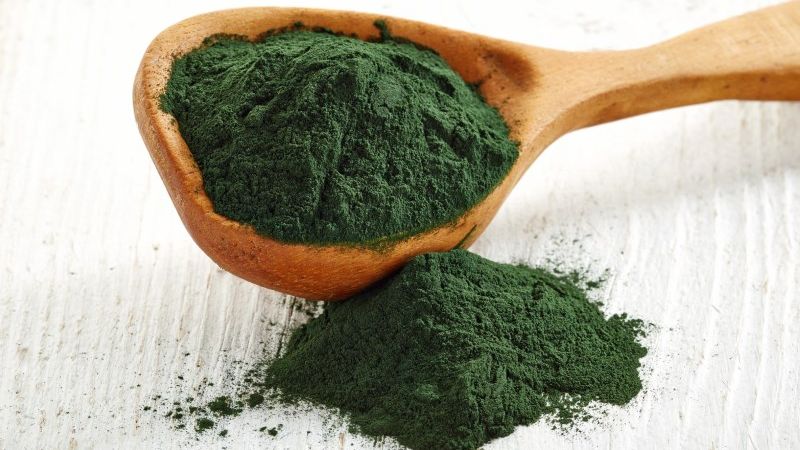Blue-green algae tops the list of superfoods, with good reason! Here’s how using spirulina in your beauty routine can make your skin healthier than ever.
Table of contents:
What is Blue-Green algae?
What does Spirulina do for the skin?
Spirulina benefits for skin.
Best forms of Blue-Green algae.
How to use Spirulina.
If you’ve ever shopped for products to rejuvenate your skin, it doesn’t take long to notice that most formulas use harsh chemicals and known irritants. What if we told you there was a better way – one that nature itself provides?
It’s called blue-green algae, or more specifically, spirulina. It is most known for being a superfood and heal supplement, but it’s equally useful in skin care products to help heal your skin.
Read on to find out what it can do for you!
What is Blue-Green Algae?

Blue-green algae is known as a cyanobacteria, which is a type of bacteria that lives in water and get their energy through photosynthesis. Most people just know it by its common name – pond scum.
It’s a simple, plant-like organism found in both fresh and saltwater. Many varieties are toxic, but its most popular form, spirulina, is one of nature’s most nutritious gifts. It gets its identifiable color from its photosynthetic pigment known as phycocyanin, although some variations are a pinkish-red thanks to its high carotenoid count.
Fun fact: Flamingos get their pink hue from eating a diet composed mostly of spirulina and other carotenoid-rich algae.
Having been around for centuries, spirulina was a superfood before superfoods were even cool. In fact, Hernando Cortez reported the Aztecs used spirulina much like we use cheese today. We’re not quite sure what made them look at the slimy, green substance and think “Hmm, this is probably good to eat” – but we’re certainly glad they did.
What they discovered was an incredible nutrient-dense food source that offers benefits for virtually every part of our body – especially skin.
What Does Spirulina Do for the Skin?

Spirulina is highly nutritious, containing 8 essential amino acids. It is also high in protein, which is necessary for cell repair and growth. On top of that, spirulina contains a rare fatty acid known as gamma linolenic acid.
Why does that matter? Fatty acids, especially GLA, are known to promote the structural integrity of skin and decrease skin inflammation. That combined with being a rich source of antioxidants makes spirulina highly effective in the fight against free radicals.
Free radicals are mostly discussed in regard to cancer, but they’re also the pesky things that damage skin, making it look older than it should. With the help of antioxidants, free radicals can be eliminated by increasing the skin’s metabolism, which is exactly what spirulina does. It helps your body produce new, healthy cells faster. When that happens, you’re left with fresh, glowing skin.
Fight Candida, Detoxify Your Skin & Soothe Atopic Dermatitis with Spirulina

While great for skin, the benefits of spirulina don’t stop there. As a natural antimicrobial, this famous blue-green algae actually kills off candida (aka yeast), which is often the underlying cause of acne breakouts.
It also helps detoxify heavy metals, especially arsenic. A study shows a combination of spirulina and zinc decreased arsenic concentrations in participants by up to 47%!
There are also some indications that spirulina can promote immune system function, fight off infection and help prevent cancer (thank you, antioxidants!). Other incredible benefits include:
- Lowers blood pressure
- Reduces risk of stroke
- Relieves nasal congestion
- Lowers cholesterol levels
- Suppresses appetite
- Boosts energy
There’s even evidence that spirulina can reduce signs of aging caused by exposure to UV light as well as help patients who have atopic dermatitis (eczema and related conditions). This means it’s a great ingredient to include in creams for damaged skin like Cream.
Best Forms of Blue-Green Algae

Spirulina is available in pill or powder form as well as flakes. In these forms, it’s most commonly dried or freeze-dried to make it more convenient to take.
Most spirulina available today has been cultivated in a laboratory, as the risk of contamination and pollution in lake waters is too high. Spirulina maxima (from Mexico) and spirulina platensis (from California) are the 2 most readily available varieties.
Finding an organic source will make sure no chemicals were added. And be sure to check the label to make sure it isn’t being “watered down” with fillers.
How to Use Spirulina

Many people simply take spirulina as a nutritional supplement in the form of capsules or tablets. The University of Maryland Medical Center suggests a dosage of 4 to 6, 500-mg tablets each day.
One of the easiest ways to take spirulina is to simply add it in a smoothie. It can also be mixed into pesto or a frittata with other green vegetables – try broccoli or spinach! Spring rolls and soups (like cream of broccoli) are also good choices for a little spirulina.
For skin conditions, it’s best applied topically in the form of a face mask, cream or lotion. A good lotion will allow the nutrients to penetrate in to the deeper layers of skin. That is were the magic really happens.
Want to try it in a cream that also contains 15 other superfoods to heal skin, reduce inflammation and sooth irritation? Click the link below to order your bottle:
Summary
Who knew pond scum was hiding a nutritional powerhouse? High in protein and one of the top sources of gamma linolenic acid, spirulina deserves a place in everyone’s skincare regimen.
Just remember, it can be contaminated easily if not sourced properly. It’s important to purchase blue-algae products from reputable companies.
Have you tried spirulina? What did you think?


